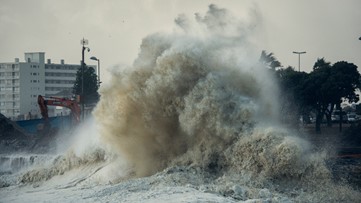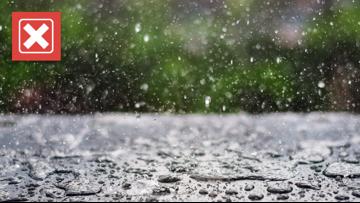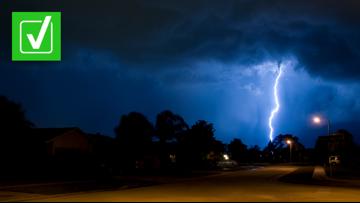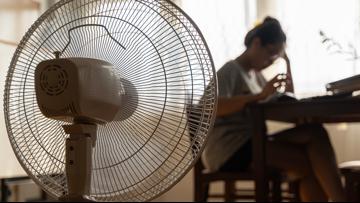HOUSTON — According to our hurricane preparedness experts, no plan or a lack of planning can spell disaster before a potential tropical system arrives.
During hurricane season from June 1 to November 30 every year, people who live in the states bordering the Atlantic Ocean and Gulf of Mexico are urged by the experts to have a hurricane supply kit in the event a system makes landfall.
Anytime there is the possibility of severe weather homeowners and renters can take precautions to ensure their home is protected against potentially dangerous elements. The KHOU 11 VERIFY Team went to the storm preparation experts in Texas and Louisiana to find out how to properly make sure your home is safe from an incoming tropical system.
THE QUESTION
- Will taping windows will prevent hurricane-force winds from shattering them?
- Will opening windows or doors during a hurricane will stabilize pressure?
- Should you wait to evacuate before a storm?
THE SOURCES
FEMA
NOAA
CDC
Insurance Institute for Business & Home Safety
LaHouse Research and Education Center/LSU AgCenter
Texas A&M Extension Service
THE ANSWERS
- No, Taping windows will not prevent hurricane-force winds from shattering them.
- No, Do not open windows or doors during a hurricane.
- No, Do not wait to evacuate.
WHAT WE FOUND
1. Taping Windows/Reinforcing windows & doors
Across social media, people share their ways of protecting their homes before hurricane or tropical storm conditions arrive in an area. One of the myths floating around since before Hurricane Andrew made landfall in August 1992, was putting tape in an 'X' pattern on a window to protect it from shattering.
Experts tell the KHOU 11 Verify Team, that the tape will not prevent the window from breaking and could become a bigger threat that could send larger pieces of glass inside the home.
According to the experts, Texas A&M Extension Service recommends using hurricane-proof windows, or shutters to protect your windows from potentially breaking during a storm. A cheaper option is nailing plywood over your windows. According to County Extension Agent Brandi Keller, labeling and pre-cutting the plywood window covers ahead of time can help save you time while you are getting ready for an incoming storm.
Keller also tells the KHOU 11 Verify Team, you should re-enforce all windows on your home, saying "Anywhere there's going to be a wind any of those windows can be at risk."
2. Opening windows & doors during a storm
According to South Carolina-based Insurance Institute for Business & Home Safety (IBHS), you never want to leave a window or a door open during a storm. Online people comment inside chat rooms suggesting the slight crack could help relieve pressure inside the home. Experts at IBHS put this theory to the test inside their lab.
According to Dr. Anne Cope, chief engineer for IBHS, "...When you allow wind to get in, whether it's a small crack, whether it's a garage door that has buckled just a little bit and is letting more wind in if you give that an opening now, the wind pressure attacking your house is going to blow things up like a balloon."
In a video provided to the KHOU 11 Verify Team, IBHS laboratory results show the roof flying off the home, proving the wind can threaten your home's structure in a storm. Dr. Anne Cope says, "You are inviting Mother Nature to come into your house when you leave doors and windows open. And she is a terrible houseguest. she makes a terrible mess."
3. Knowing when to evacuate
When a storm is approaching, officials will decide if or when an area should be evacuated. Waiting too late to evacuate from your home could force you to ride out the storm until help can safely get to your area. All tropical systems are different and never take the same path. It's why officials urge caution against assuming you are safe in your home because of previous storms.
Texas offers an evacuation program called, "State of Texas Emergency Assistant Registry" (STEAR), to get people who may need assistance evacuating to safety. To register for the program you can dial 211 and place yourself or a loved one on the registry.
According to Nikki Fitzgerald of Texas A&M Extension Service, the program covers the whole state no matter the disaster.
During an evacuation, FEMA urges anyone in the disaster-affected area to be prepared to be away from home for an extended amount of time.
If you are self-evacuating you should let friends and family know before you leave for your safe destination and when you arrive.
Homeowners should secure their homes, by making sure electrical equipment like small appliances, and televisions are unplugged, along with shutting off the water, and gas if you believe there will be damage to your home. According to FEMA, you can leave your freezers and refrigerators plugged in, unless there is a risk of flooding.
How to get your home storm season ready
According to IBHS, chief engineer Dr. Anne Cope renters and homeowners should be surveying their homes and assessing what needs to be picked up before the storm arrives. Items like branches, yard toys, and outdoor furniture need to be secured because they could turn into a threat to your home's structure when the storm arrives.
If you have a garden you want to ensure survives the storm, according to Brandi Keller of Texas A&M Extension Service:
Check large shade trees on your property to make sure they are structurally sound. Large, dead branches should be removed, especially if they hang over the ground or driveway.
If unsure about the health of a tree, find a reputable, certified arborist in your area at treesaregood.org
Texas A&M Extension Service lays out how you can prepare for all coastal natural disasters including storm surge and flash floods. You can access the manual by clicking here.










